Return to main Vanishing B.C. page Return to home page
This page last updated January 18, 2022
© Michael Kluckner
Go to section on historic trails & roads in this area

|
The familiar first view of Alexandra Lodge, as it looked to me in September, 2001, travelling east on the Trans Canada highway. |
|
Written in 2001: There has been a roadhouse or lodge at Chapman's Bar in the Fraser Canyon since 1858, four years before the Cariboo Road opened and Joseph Trutch's workers completed the Alexandra Bridge nearby. The question is whether any portion of this building is the original (actually the second, 1864) roadhouse, which would make it one of the oldest and most historic buildings in B.C. The provincial government gave it a heritage designation in the early 1970s, but withdrew it a decade later when a subsequent review appeared to reveal that the building only dated from the 1920s – the highway era when auto tourism and long distance trucking began and the Fraser Canyon Road reopened along the old Cariboo Road route as a toll road. In the early 1980s, the provincial heritage branch dismissed the lodge as "only of local significance" – rather a death sentence as it has turned out, exacerbated by the loss of traffic on the Fraser Canyon highway due to the opening in 1986 of the Coquihalla highway (#5). By 1864, two years after the Cariboo Road and Alexandra Bridge opened, innkeeper William Alexander went into partnership with Louis Waigland, who had purchased 32 acres beside the Cariboo Road above Chapman's Bar. They built a large, two-storey frame roadhouse there, an 1867 photograph of which (by Frederick Dally) survives in the BC Provincial Archives (the image number is A-03865 if the pathway in the link doesn't work). |
Detail of the Frederick Dally photograph referred to above
|
That building had a simple fore-and-aft pitched roof with side gables, a central chimney and five windows along its front facade. Much of the original property was forfeited for CNR construction in the 1910s. The current Alexandra Lodge has obviously been assembled from other buildings, some portion of which may be the 1864 roadhouse (but that's unlikely). Old photographs confirm that the current building had "emerged" by the 1930s. The roofline and main floor of the northern half (minus a proposed dormer) reflect the 1926-1927 plans by Vancouver architect Willliam Frederick Gardiner, the front elevation of which is reproduced below, entitled "Proposed Hotel to be Erected at Chapmans, Fraser Canyon Highway, B.C. for The Cariboo Hotels Ltd." But the rest of the building is very different, including the main gable and the odd south-side wall – in the watercolour above, the strong vertical shadow below the peak of the gable indicates the difference in size between the front half and the rear half of the building – the front half is a few feet longer. Also note the differences between the porch structure as built, in the photos below, and the proposed hipped-roof one on the architect's elevation. Adding further confusion is the 1924 photo, which may be another building entirely on a slightly different site, since demolished. Possibly the entire W.F. Gardiner plan was built in the late 1920s, but the south side was destroyed by fire soon after construction. In the lodge's heyday, its first two decades of operation, it apparently was run by the Barrett family in a very elegant style. Correspondent Doris Tuohey, who first travelled up the Fraser Canyon in 1929 and spent a lot of time in the 1930s and 1940s gold-panning and vacationing in the area, recalled white linen cloths on the tables and filet mignon on the menu. The proprietress had straight-cut hair, an Irish brogue and smoked a pipe; her husband was a "well-educated Englishman." Prajadhipok, the King of Siam, stayed or stopped there with his entourage during his tour of BC in September 1931. Later owners, including Dorine Hooper who had a well-deserved reputation for her cinnamon buns, struggled to keep the lodge going until she closed it finally around 1995. The roadhouse was moved in 1952 six feet from the road right-of-way by a highways department crew and placed onto a concrete foundation. [Correspondence from Peter Rowlands: Your delightful website was 'discovered' while researching a book about Pete Friesen, proprietor of Modern Building Movers, who moved Alexandra Lodge c. 1952 for the provincial highways department. Having got his start moving houses during the 1948 Fraser Valley Flood, Pete was contracted to relocate buildings to allow for improvements along the Fraser Canyon Road. He went on to become the acknowledged world leader in the field of structural moving - inventing the technology and supervising the relocation of Cape Hatteras Light, Newark NJ International Air Terminal, Gem and Shubert Theaters, Fairmount Hotel, railway stations, fire halls and 5000 various other buildings.] |
|
|
A photo in the collection of the
Yale and District Historical Society, stating that this is the
Alexandra Lodge in 1924, and that it was renovated in 1926-1927.
The building in the distance is the Chapmans CNR station. This
is probably the building referred to as "Chapman's House" and
owned by a widow, Mrs. Alice McGirr. From Gary Tupper, 2013: Just a note to inform you that the "widow Alice McGirr" was born at Chapman's Bar in 1866/67 - née Alice Alexander. Presumably William Alexander's daughter. |
A portion of the W. F. Gardiner plans for the proposed
hotel at Chapman's Bar, c. 1926-1927. (Yale & District Museum and
Archives)
|
A late-1930s postcard, photo by "Vipond." The building is much the same today, although the trees on the south (near) side are long gone. Also disappeared is the B-A gas station in the background, which deteriorated badly and suffered a collapsed roof from snowload in the early 1990s. Its ruins were burnt about 2000. |
A postcard from the 1930s, photographer unknown. There are still scattered cabins behind the lodge, in one of which I stayed in 1992. |
Update 2022: Saviours of the Lodge arrived, in the form
of Shirley and Ken MacKinnon! Here is an
article in the Hope Standard of the restoration work they're
doing. And they have a
Facebook page documenting the progress.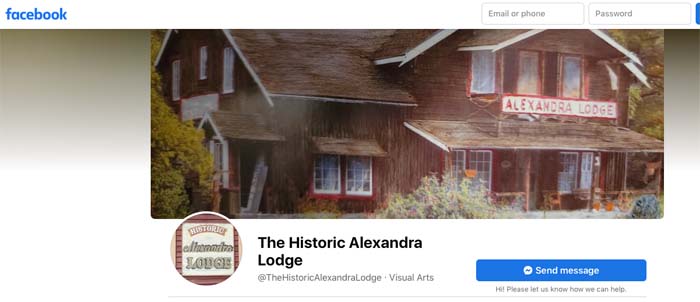 From Bonnie Campbell, 2020:
|
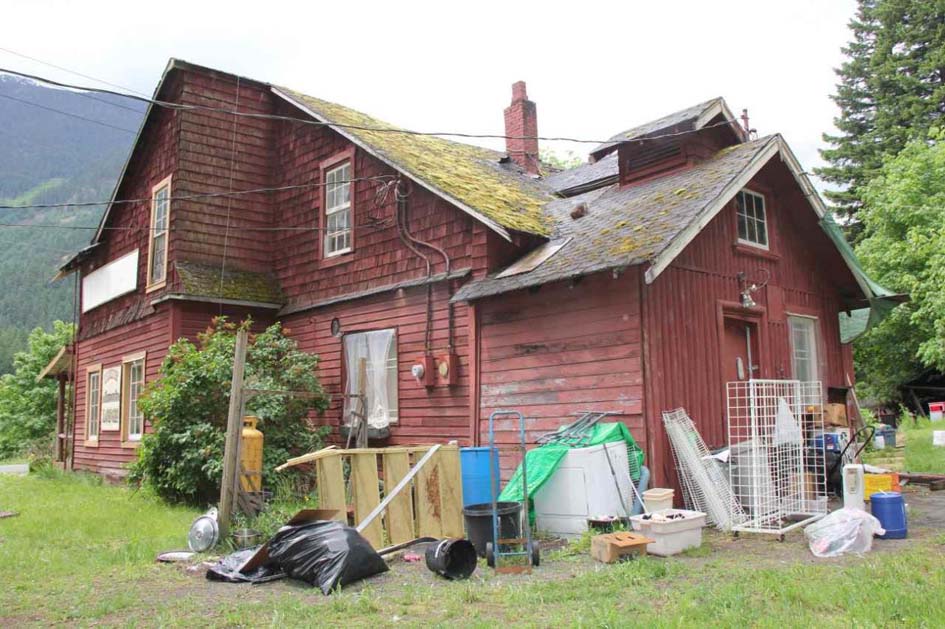
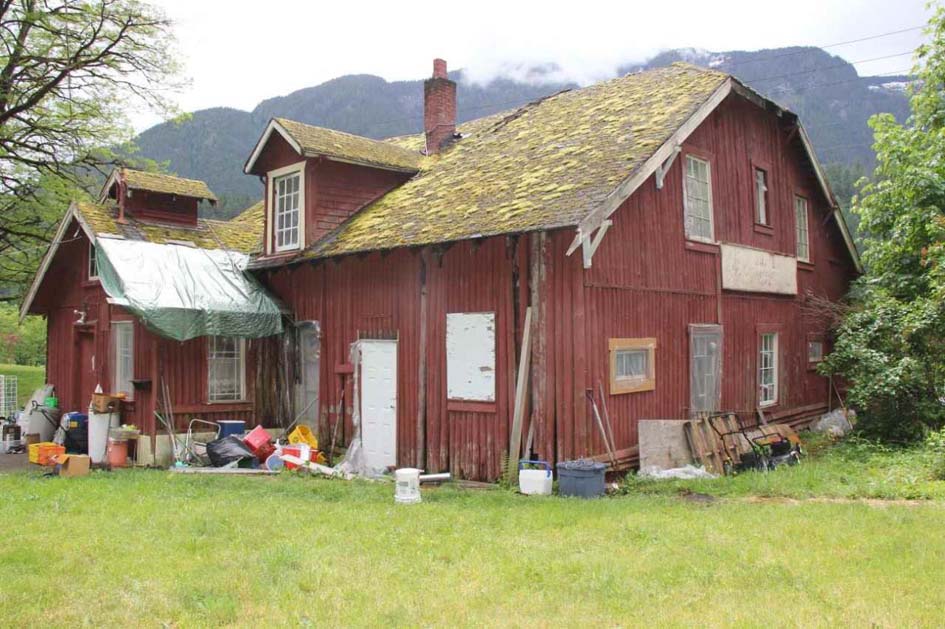
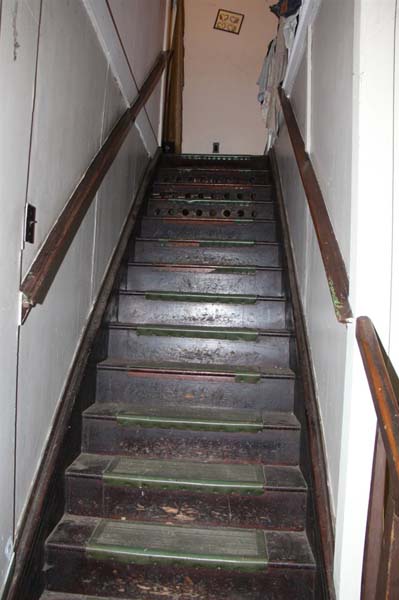
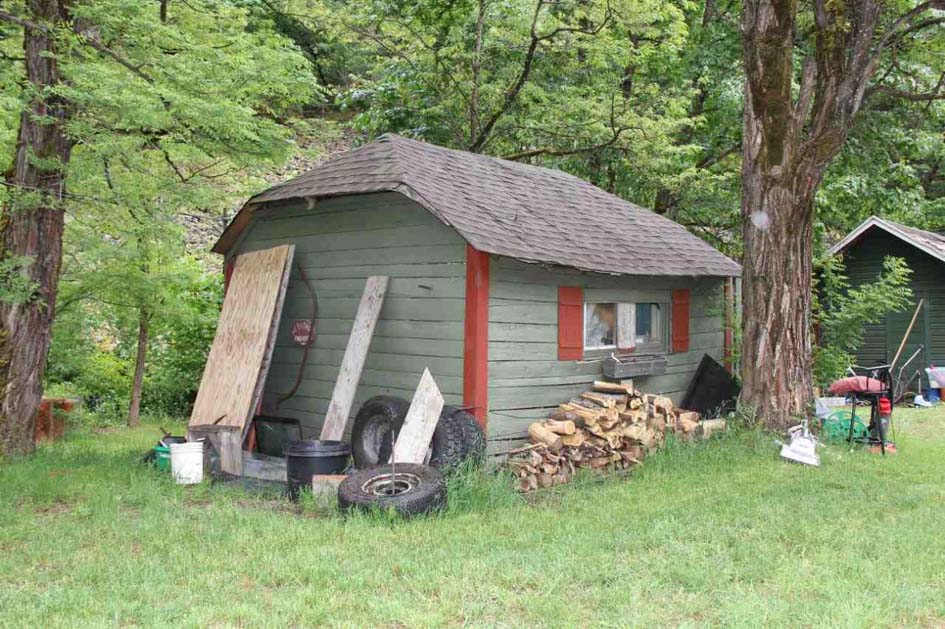
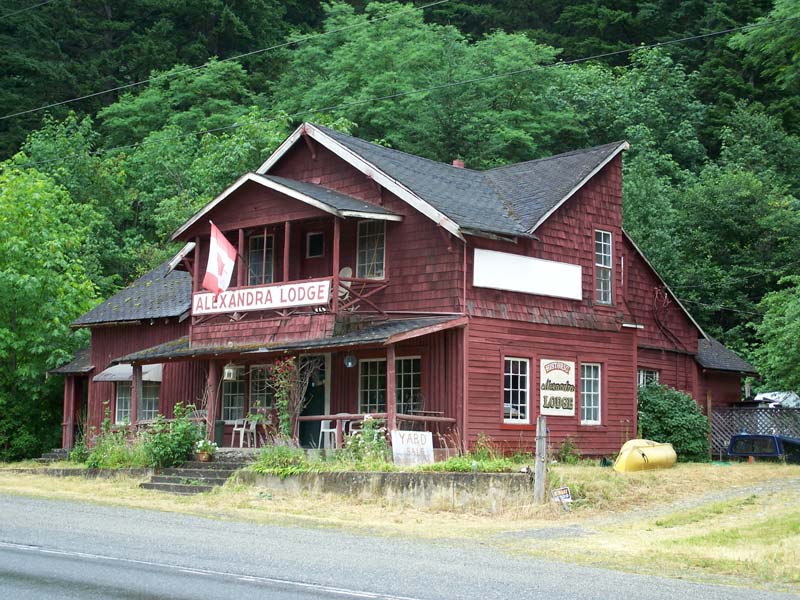
Photo from Sue, 2011
Photo by Leeanne Page, July 2004 – the lodge occupied and cared for, at last. But apparently about to be resold.
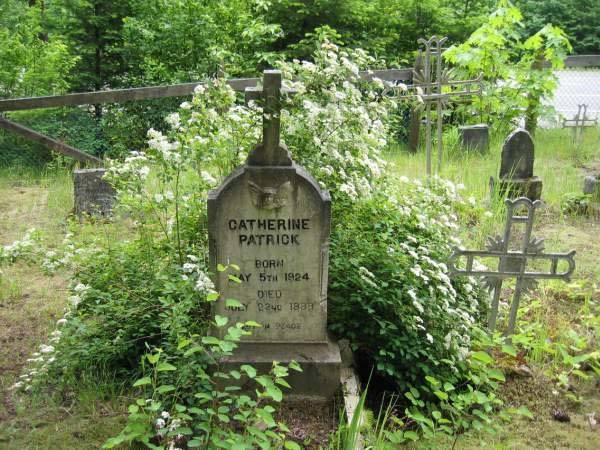
| The cemetery next to the lodge, photograph by
Marilyn Roberts, 2005 From Martin Thorson, 2015: I really enjoyed reading your interesting accounts of history, especially about the old Alexandra Lodge.. It means something to me, as my late father told me he had stopped and stayed at the Lodge on a trip to the coast with my grandparents. I have no idea exactly what year this was... Whenever I'm passing through, I always stop there..I am a photographer too, and actually took a very similar photo of the one in the small cemetery right near the house.. The gravestone of Catherine Patrick stands out the most.. I was curious why this 14 year old had such a short life and how she might have been connected to the old Lodge. From the Division of Vital statistics I found some information about Catherine Patrick. Catherine was a native girl who died in Chapmans,B.C. on July 22,1938 ... The cause of her death was pulmonary tuberculosis.. Catherine's fathers name was Patrick Charlie who was born in Yale, BC. Her mother's maiden name was Annie Chapmans... Since she was buried there perhaps her and her parents had some connection to the old Lodge. |
|
From Donna Butler, 2020: Years
back we were driving back home from interior and stopped in to
the lodge as it said OPEN. We met the lovely gal who had made
stew and fresh bread. I told her of the king of
siam etc. The king of Siam came over on the Empress of
Canada where my uncle was the purser my aunt was the
hairdresser. My uncle Harold treated the King so well, he
was presented with a cigarette case and a pair of cuff
links. As you know the Empress of Canada sunk during the
war. Later In life my grandmother Beatrice Bletsoe who was
a practical nurse went to Alexandria lodge to
nurse someone there. As a result our family would visit
around 1932 or 4 and stay overnight in one of the rustic
cabins I remember as a child as it was a big deal and long
trip. I have a pic of us up there then but locked in locker. The
cigarette case and cuff links are still in the family estate.
They would not know the historical value if any. As far as I am
concerned the Lodge was a part of my life and took an
interest HOPE this fills In a couple of blanks. From Mary Cull, Melbourne, 2015: I am connected genealogically with Henry Bertram Clegg and recently have been researching his life. He was born in Yorkshire, emigrated to Canada in 1921, served in WW1 and married a Canadian, Kathleen Lily Chadwick. Their probate records note their place of abode Alexander Lodge. Along the way I have found your website. I am interested in the reference by David Pollock about Henry being wounded in the war. But I am equally interested to know if by any chance there are photographs of Henry and his pipe-smoking wife. I can only assume that if you had some you would have added them. ... and furthermore, 2016: Now I think I was wrong about Lily being born in Canada. Her death record on the Find a Grave Index website states that she was born in Ireland I have been unable to find a definitive birth record for her but a baptism record in Ireland under her name shows up but it does not give a date. Another record for Cathleen Lilian Chadwick gives a birth in Dublin South in the 3rd quarter of 1893 which fits with her D.o.B. in August 1893 but not with the spelling of her name.From MK: below are photos of the
Cleggs which I used in the book Vanishing British Columbia.
Henry Bertram Clegg (from Yale and District Museum)
Kathleen Lily Chadwick Clegg (Yale
and District Museum and Archives photo)
From Monica Olesky, 2014: I
was answering some questions on Family Trees for one of my
grandaughters. She was asking about childhood experiences
and as I went back through the years, I recalled living at
Alexandra Lodge in the fall/early winter of 1947. My
mother, Joan (nee Langley) Barrett had ‘inherited’ the settling
of the estate from Lily Clegg – a relative – at the time of
Lily’s death. From what I understand, Lily had the Lodge on a 99
year lease – again, I have not found any documentation, but I
remember seeing records after my mom died (1994). I may be able
to locate something. We lived in Trail, B.C. at the time;
my sister, Judy, was 5, and I turned 3 in October.(I was
delivered to my Grandmother Bessie Langley and my aunt Barbara
Langley in Merritt for a sleepover for a few days). My dad, Ed
Barrett, was working for Cominco (later becoming the industrial
psychologist for Cominco)He was only able to visit us for short
weekends. From Laurier Lebel in Québec, 2011: Je vous achemine une vieille carte postale que j'ai découverte dans les affaires de ma grande tante qui a voyagé dans l'ouest canadien il y a fort longtemps.
Note from Robin Collins, Ottawa, 2010: I thought you'd
like this scan of the A. Lodge. An old family photograph with
Cada ("Ked") Billings standing in front.
Note from David Pollock: The pipe smoking proprietress was Lily Clegg [Kathleen Lillian Clegg, 1893-1947] and she was the driving force behind the lodge in the 20s and 30s. Her husband [[Henry Bertram Clegg 1888-1942] had been injured in WW I and never fully recovered. The electric light at the lodge was a water driven unit installed by my Uncle Dave Laverock and his partner Jimmy Swan ( JB). Dave was astounded to see Mrs Clegg stirring soup with a cigarette ash over an inch long on the end of her cigarette . It is not known if she eventually dropped it in the soup, but she put on a good meal. One very cold winter, she and Mr Clegg went to Vancouver. Whoever was left as caretaker was warned not to shut off the water to the generating plant as it would freeze. They did and it did. The penstalk was a four inch steel pipe, threaded together with couplings every ten feet. Mrs Clegg had the person responsible uncouple the steel pipe length by length and drag it into the little service garage where the generator was located and with a huge fire roaring in a barrel stove thawed it out length by length. It was then reassembled and the plant was restarted. I saw this generating plant when it was still operating in 1962. I am sure the unit (Pelton wheel and generator) is now in storage at the Saanich Artifacts museum. If not, the unit they have is a twin. JB Swan's brass tag is riveted to it. Siska Lodge also had their
own water powered lighting plant. Much larger than Alexandra's.
It ran up to the time the lodge burned down in 64 or 65. I also
saw it in operation as well as a number of others beginning at
Bridal Falls Chalet and up as far as BigHorn or Shaw Springs. It
has been many years (1962) since I first travelled the Fraser
Canyon with my uncle but he remembered it well from the 1930s.
We purchased the equipment from the Bridal Falls Chalet in 1963
and the wheel is still running on our farm outside Victoria on
the site of the original Hudson Bay Mills (1848-56 ). My
father's mother's family were the Finnertys who arrived in
Victoria in 1862 and whose farm now forms part of the University
of Victoria's campus. My grandfather M B Pollock made a number
of trips into the Yukon over the Chilkoot pass between 1894 and
1898. July 2004: ad in Langley Times: "8 1/2 acres, 7 bedroom, 12 mi. N of Yale, 1 mile Fraser River front. $350,000. Historic Alexandra Lodge. 604 869-2975." Note from Tyler Shepherd, 2004: "Hi! I saw your site on the Alexandra Lodge in the Fraser Canyon, and I do have a lot of information regarding the current state of the property. I may be able to send you a bunch of more current photos of the place, as I am going up there with a group of friends at the end of the month, and we will no doubt have some pictures. As for the ownership, my father, David Shepherd, has obtained the lodge from Dorine Hooper, and has a lot of plans to clean it up, renovate, and get it much more active. He currently lives in the lodge, and has redone the water system, plumbing, much of the interior, and the electrical work. If you would like, I could let him know, and then give you his phone number, so you might direct inquiries you receive his way. I look forward to hearing from you soon, as we share an interest in this lodge, it seems." Note from Andrea Jarman, 2008: The information you have on the Alexandra Lodge is incorrect. David Shepherd never did purchased the Lodge from my Grandmother Dorine Hooper, none of the renovations took place??? She still owns it and my uncle lives there. Unfortunately all efforts to have it declared a place of Historic Significance have failed and my family does not have the money to restore it. It used to be a great place for my brother and I to spend summers....My Grandparents used to run it as a bed and breakfast. My Grandmother's cinnamon buns were famous from BC to China and back. I still have not given up on it though. I would love to see it restored to its former glory and have its rightful place in history acknowledged.Note from Ada Stefanek, 2005: As a child back in the mid to late 50's, my parents and I would drive up the canyon (in the old Model T) to visit a former owner (possibly) of the Lodge. I remember going across the Alexandria Bridge and chugging up the hill to the Lodge. However, on reading the write up on the internet, I didn't come across the name "George Hood" anywhere as being a former owner. George used to work with my father in Vancouver on the street cars and according to my mom, bought the lodge and ran it for a while. Mom looked through her old photos and has a picture of George and my dad in front of the lodge taken in the late 50's. Ever heard of him ? Perhaps his tenure was to small to be noted. Note from John Gulayets, 2005: I was on the internet and was looking up Spuzzum B.C and came across the lodge. My uncle George and Aunt Vera HOOD ran the lodge from around 52/53 till about 74 Uncle George died in 1972 and Aunt Vera died about 4 - 5 years later. I used to stay at the lodge every summer when I was a kid and used to pump gas for the cars and do little odd jobs. Cut the lawn. The water system was pretty cool and would break down occassionally and my dad would drive up and help fix it. Lots off good memories from there. Aunt Vera made good burgers and she was a phenomenal cook. |
|
|
Photos from Ada Stefanek, Coquitlam, BC: left, camping in the Fraser Canyon, 1951; below left; her mother Margaret at the Alexandra Lodge, 1955; below, her father Harold Thomas on the left with George Hood at the lodge. |
|
|
|
|
The remains of the Anderson Brigade Trail of 1848, used briefly by the Hudson's Bay Company, ascend the ridge behind the Alexandra Lodge.The trail began at Fort Yale, crossed the river at the narrows at Spuzzum and continued to Merritt. It was the first attempt post-contact to establish a route through the Canyon. Above the Alexandra Lodge site, the trail climbed a steep hill to Lake House and on to Fort Kamloops. Anderson's trail also connected to an Indian pack trail from Boston Bar to Merritt. The route was superseded after the 1849 season by the Hope to Tulameen brigade trail. Documented as a route to Fort Kamloops from 1847 to 1849, and later in 1858 and 1882 as a route to Boston Bar. The site of Lake House has not been found. An 1858 gold mining trail returns to the Canyon via 17 Mile Creek. (Lillooet-Fraser Heritage Resource Study. volume I, Heritage Conservation Branch, Province of BC, Ministry of Provincial Secretary and Government Services, 1980) Much of the forest along the trail has been logged over the years, but the first seven kilometres, starting near Alexandra Lodge, is more or less untouched. The Summer, 1999 issue of the Heritage Society of BC newsletter reported on the efforts of Charlie Hou, a Burnaby secondary school history teacher, who had been taking his Grade 10 students on an overnight hike along the trail for several years, to have the trail designated by the provincial Archaeology Branch. Mr. Hou proposed provincial park status for the trail, but his efforts were not acted upon before the change of provincial government in 2001 (and the current provincial government, which is cutting all department budgets, is unlikely to act). However, the trail is reported under a "map reserve" status according to a Memorandum of Understanding between the Archaeology Branch and the Ministry of Forests; this could mean the preservation of a strip 100 metres wide on either side of the trail. Heritage trails get $2 million
boost [article sent along by Rick Goodacre, Heritage Society
of BC] *** Please read the section on the Dewdney Trail for some background on A.C. Anderson and the Hudson's Bay Company brigade trails.* * * Please also read the material on the Spuzzum Cafe, the Spuzzum Hotel and the Alexandra Bridge if you're interested in this area. |
